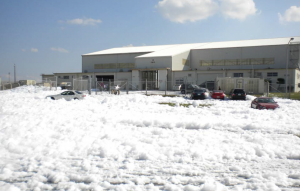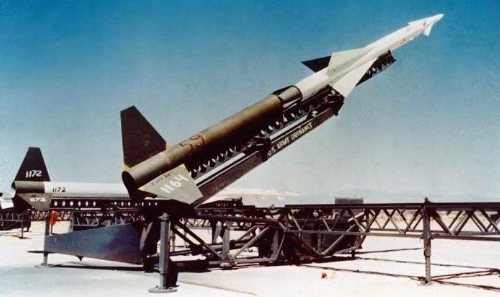
The US military has contaminated the drinking water for almost half-a-million Japanese — but Japanese authorities can’t do anything about it.
Jon Mitchell / The Diplomat
(October 12, 2020) — Host to 31 US military bases, Okinawa, Japan’s southernmost prefecture, is no stranger to the risks of bearing the burden of the US-Japan alliance. In 1959, the US military accidentally shot a nuclear rocket into a local harbor [See story below — EAW]; six years later, it lost a hydrogen bomb in nearby seas; then in 1969, a leak of nerve agent on the island so shocked the world that President Richard Nixon was forced to renounce his nation’s first-use policy on chemical weapons.
But these incidents pale compared to what Okinawans are facing today: the US military has polluted the drinking water for 450,000 people — a third of the prefecture’s population — in the worst case of environmental contamination in the island’s history.
The chemicals causing the problem are per- and polyfluoroalkyl substances (aka PFAS), which are used in the production of food wrapping, nonstick cookware and military firefighting foams. PFAS are highly resistant to heat, oil and water, but in these strengths lie their dangers.
Virtually indestructible in nature, they accumulate in our bodies, taking decades to expel. According to the US Agency for Toxic Substances and Disease Registry, health problems linked to PFAS include cancers of the kidneys and testicles, high cholesterol and decreased vaccine response — a particular concern during the current pandemic.
Okinawans first realized their island was contaminated with PFAS in 2016 when tests by local authorities detected high levels of the substances in rivers running through and near Kadena Air Base, the largest US Air Force installation in the Pacific. The discovery prompted further checks near military facilities on the island, revealing elevated PFAS levels in spring water, fish and farmers’ fields.
Most alarming, prefectural officials found PFAS in the island’s drinking water, which is sourced from rivers near Kadena Air Base and an aquifer beneath the facility. Levels peaked at 120 parts per trillion (ppt); as a comparison, the US Environmental Protection Agency recommends a maximum level of 70 ppt — but even this, say experts, is way too high.

US military poisons cloak Okinawa air base.
The contaminated drinking water is supplied to seven municipalities — home to 450,000 Okinawans, thousands of US service members and their families, and, at least in pre-pandemic times, millions of international tourists. Checks on residents who regularly drank the water showed that blood levels of some PFAS compounds were 53 times higher than the national average.
The findings shocked many Okinawans — but perhaps they shouldn’t have come as a surprise. PFAS contamination from firefighting foam has been detected on military installations throughout the US In March, the Department of Defense announced there were 651 stateside bases with such suspected pollution.
In the US, when PFAS contamination is discovered, the military holds meetings with local communities and supplies them with alternative water sources. The Department of Defense has also admitted to PFAS contamination at its bases in South Korea, Belgium and Honduras.
So how has it responded to polluting the drinking water for 450,000 people in Japan? With a deafening silence.
In 2016, Okinawa government officials asked permission to inspect Kadena Air Base. Four years later, they’re still waiting for approval, while requests by local residents have been met with similar silence. When the Pentagon does deign to comment on the matter, it claims that it can’t be sure of the source of the contamination.
In 2019, for example, a military spokesperson told the media, “It would be inappropriate to speculate where the presence of [PFAS] in off base waterways originated.” (Okinawa possesses no large-scale industries that manufacture or use the substances.)
One way to pry open the military’s opacity has been via the US Freedom of Information Act. Internal reports from Kadena Air Base reveal that between 2001 and 2015, the facility mistakenly released at least 23,000 liters of various firefighting foams. One notable case from 2015 involved a drunk marine trespassing into one of Kadena’s hangars and activating the sprinkler system; military reports described the act as “vandalism.” In-house documents also confirm PFAS hotspots within the base.
Posted in accordance with Title 17, Section 107, US Code, for noncommercial, educational purposes.
US Army Veteran Gives Interview on 1959 Naha Accidental Nuke Missile Firing

Robert Roepke in Wisconsin speaking about the accidental firing of a Nike Hercules missile from US Naha Air Base in June 1959.
WASHINGTON (October 26, 2017) — On June 19, 1959, a Nike Hercules surface-to-air missile equipped with a nuclear warhead at US-controlled Naha Air Base was accidentally ignited and fired due to a maintenance error, and ended up submerged in the ocean.
A former US Army Nike Hercules missile maintenance man who was at Naha Air Base during the incident, now 81-year-old Robert Roepke of Wisconsin, provided his account in an interview with Ryukyu Shimpo.
Roepke said that just before the missile was fired a blue-alert had come down. This meant the battery was preparing for potential missile launch due to a perceived threat.
The Nike Hercules battery to which Roepke belonged recognized that even after the incident occurred, another missile, this one equipped with high explosives, was being made ready for launch.
Roepke first made details of this accident public this September during the broadcast of an NHK special titled Okinawa and US Nuclear Weapons (Okinawa to Kaku).
According to Roepke, the accidentally fired missile contained a warhead similar in size and yield to the atomic bomb dropped on Hiroshima.
While the missile equipped with high explosives was topside, a stand down order came through the chain of command. One soldier was immediately killed due to the accidental firing, and another died a week later.
The National Personnel Records Center (NPRC) of the National Archives at St. Louis, Missouri, has the Nike Hercules battery’s daily reports for safekeeping. On June 19 that year, the report recorded the cause of the soldier’s death as “ignition of a Nike Hercules missile.”

This accident could have resulted in a catastrophe, but the US military announced no details of the incident and had the missile recovered from the ocean in secret. The battery’s daily records on the next day and onward note duties being executed as usual.
At that time, Roepke was in charge of missile assembly and maintenance. He said that, after the incident, the battery received a communiqué from incident investigative teams belonging to organs like the Department of Defense and the Central Intelligence Agency.
However, the incident was kept secret, and those involved were forbidden to disclose anything about the accident.
During the Cold War, US-occupied Okinawa bore a large quantity of US nuclear weaponry. This lasted between the mid-1950s and 1972, when Okinawa was returned to Japanese sovereignty.
The Department of Defense announced for the first time in 2015 that the US had possessed nuclear weaponry in pre-return Okinawa.
(English translation by T&CT and Erin Jones)
Posted in accordance with Title 17, Section 107, US Code, for noncommercial, educational purposes.